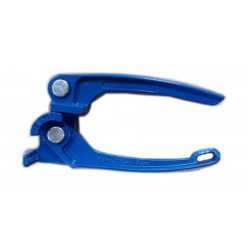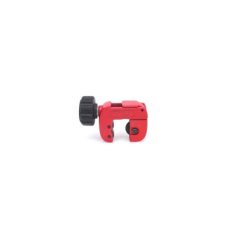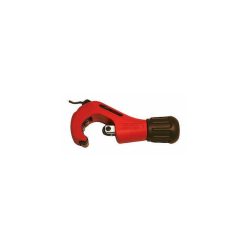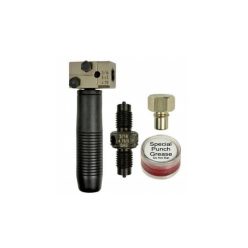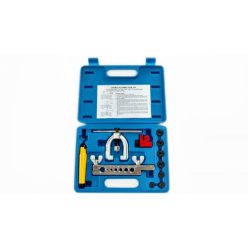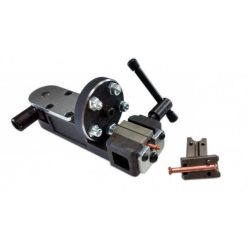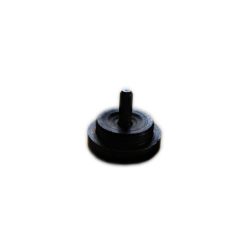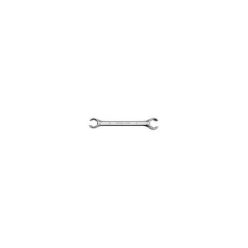The Brake System Tools category includes specialist brake pipe tools for bending, cutting and flaring rigid brake and fuel lines. TURBOWORKS pipe benders, mini and telescopic tube cutters, 4.75/4.8 mm single/double flare flaring tools and flare nut wrenches let you build and repair hard lines to OEM-level quality. With the correct tools you can create leak-free flares, accurate bends and correctly torqued fittings, reducing the risk of damaged pipes or stripped unions in high-pressure braking applications.
Net price: 16 €
Net price: 7 €
Net price: 21 €
Net price: 99 €
Net price: 399 €
Net price: 53 €
Net price: 329 €
Purpose and Benefits of Brake System Tools
Brake system tools are designed specifically for safe, precise work on hydraulic brake and rigid fuel lines. The category covers hand-operated pipe benders for 3–6 mm tubing, compact and telescopic tube cutters, 4.75/4.8 mm flaring presses for DIN single and double flares, and dedicated flare nut spanners. With this equipment you can fabricate or repair hard lines that match OEM standards, ensuring that the hydraulic system maintains its designed pressure rating even under repeated hard braking on road or track.
Brake and clutch circuits can see several hundred bar of pressure during emergency stops. Poorly executed bends, rough cuts or badly formed flares can introduce cracks, thinning or misaligned sealing surfaces, leading to leaks and sudden loss of braking. TURBOWORKS flaring presses and pipe tools are built to work with common 4.75 mm (DIN) steel and copper-nickel brake lines without collapsing or scoring the tube. Investing in the right tooling not only speeds up fabrication but also greatly reduces the chance of failures that would be unacceptable in such a safety-critical system.
Technical Basics
The pipe benders in this category are intended for 3–6 mm outer diameter tubing, covering conventional 4.75 mm brake pipes as well as some fuel and vacuum lines. The bending former and shoe are profiled to support the tube around its circumference, preventing it from flattening into an oval or kinking at the inside radius. With a quality bender you can repeatedly form 45°, 90° and more complex bends so that hard lines follow the chassis and suspension neatly without stress points or micro-cracks in the material.
Mini tube cutters are used for clean, square cuts in copper, aluminium and steel tubing. The cutting wheel design gradually tightens around the tube as you rotate the tool, producing a neat, burr-minimised cut without crushing the tube. Telescopic cutters offer a wider adjustment range and easier handling in confined spaces. Clean, perpendicular cuts are critical because the tube end must be smooth and square before flaring; otherwise the flaring tool cannot form an even sealing surface and the joint may weep under pressure.
The various flaring presses in the category are designed for 4.75/4.8 mm brake line and typically support single flare (SF) and double flare (DF) profiles used on European DIN systems. Interchangeable dies and accurate locating cones ensure that the flare remains centred and wall thickness stays uniform around the circumference. Larger bench-mounted or vice-mounted machines (such as FT250 or WJ0100-style tools) can handle harder steel tubing with less operator effort, while smaller handheld tools are ideal for on-car repairs and softer materials.
Flare nut wrenches in 8/10 mm sizes are shaped to almost fully encircle the hex on brake unions while still slipping over the pipe. This dramatically reduces the chance of rounding off fittings, especially on older vehicles with corroded hardware. Using a proper flare nut wrench allows controlled application of torque and safer loosening and tightening of fittings than a standard open-ended spanner, which only contacts two sides of the nut.
Selection Criteria
Before buying brake tools, decide which types of lines you will be working on: only 4.75 mm steel brake pipes, or also fuel and vacuum lines in different diameters. If you plan to build an entire hard-line system from scratch, a robust flaring press that supports multiple flare standards (DIN, ISO, single/double flare) and clamps securely in a vice or its own frame is a smart investment. For occasional roadside or on-ramp repairs, a more compact, portable flaring kit may be sufficient, provided it still delivers precise, repeatable flares.
When choosing a pipe bender, pay close attention to the tube diameter range and minimum bend radius. Forcing very tight bends with an unsuitable tool can severely thin the inner wall of the tube and stretch the outer wall, weakening the line. Look for benders specifically recommended for brake and fuel pipes, with dies matched to your materials (steel or copper-nickel), and avoid improvised bending around sockets or by hand, which is likely to kink the line.
For tube cutters, check the minimum and maximum capacity and the materials the manufacturer supports. Very cheap, thin-bodied cutters tend to twist under load and can produce spiral or stepped cuts. A well-built telescopic cutter will track true around the tube, giving you a clean edge that needs minimal deburring before flaring. If you frequently cut harder steel pipe, keeping a spare cutting wheel on hand avoids being stuck with a blunt tool mid-job.
When selecting a flare nut wrench, correct sizing is critical. Using an oversize 8 mm wrench on an 8 mm fitting can quickly round off the corners, especially if the union is rusted in place. A proper flare spanner grips more of the hex and is much less likely to slip. For enthusiasts and workshops that regularly service brakes, an 8/10 mm combination wrench is effectively essential for safe, damage-free work on brake unions.
Installation & Maintenance
Working on the brake system is always safety critical, so tool use and process need to be correct. Before flaring, always clean and deburr the tube end, and verify that the length allows for the full flare to be formed. Clamp the tube in the flaring tool so that it protrudes by exactly the amount specified by the die or gauge; too short and the flare will be weak, too long and it may fold or crack. When forming the flare, apply pressure smoothly rather than forcing it in a single heavy push.
During bending, ensure that the tube is free from prior kinks or damage. Set the bender jaws to the correct diameter and apply steady, controlled force on the handle. Any cracking noises or visible surface splitting are a sign that the tube must be discarded and replaced, not straightened and reused. After cutting and deburring, it’s good practice to blow out the inside of the tube with clean air or wipe it carefully to remove metal chips that could contaminate the hydraulic system.
Tool maintenance is also important. Keep flaring presses clean and lightly lubricated on their moving parts with a lubricant compatible with workshop use (never brake fluid); dirty or dry threads will make operation rough and can impair alignment. Inspect cutter wheels regularly—if the cutting wheel is chipped or blunt, cut quality will deteriorate and tube walls may be scored. Clean flare nut wrenches and benders after use to remove brake fluid and dirt that could promote corrosion, and store them dry.
FAQ
Why can’t I just use a normal pipe cutter and open-ended spanner on brake pipes?
Standard tools are not optimised for high-pressure brake lines. Generic cutters can distort or crush the tube, while open-ended spanners only grip two faces of the nut and easily slip, rounding off fittings. Brake-specific cutters and flare nut wrenches are designed to maintain tube integrity and grip fittings securely.
Is a handheld flaring tool good enough for making brake lines?
For occasional repairs and softer materials, a quality handheld flaring tool can be sufficient if used correctly. For frequent work, hard steel tubing or full system builds, a bench-mounted or vice-mounted press gives better consistency, requires less effort and reduces the risk of imperfect flares that might leak.
Can I use pure copper pipe if I have a good flaring tool?
In many regions only steel or copper-nickel brake pipe is approved for road use, as pure copper is too soft and can fatigue. A good tool cannot compensate for unsuitable material, so always follow local regulations and manufacturer recommendations when choosing line material.
How do I know when to replace the cutting wheel on my tube cutter?
When the cutter struggles to start a cut, leaves heavy burrs, or produces visibly uneven edges, the cutting wheel is likely worn. Continuing to use a blunt wheel can damage the tube surface and compromise flare quality, so replacing it at the first signs of poor performance is wise.
Can I fabricate my own brake lines at home with these tools?
Technically yes, but the brake system is safety critical. Only attempt DIY line fabrication if you fully understand the process and can correctly bleed and test the system afterwards. If you are unsure, it is safer to let a professional workshop—using similar dedicated tools—build and install the hard lines for you.

